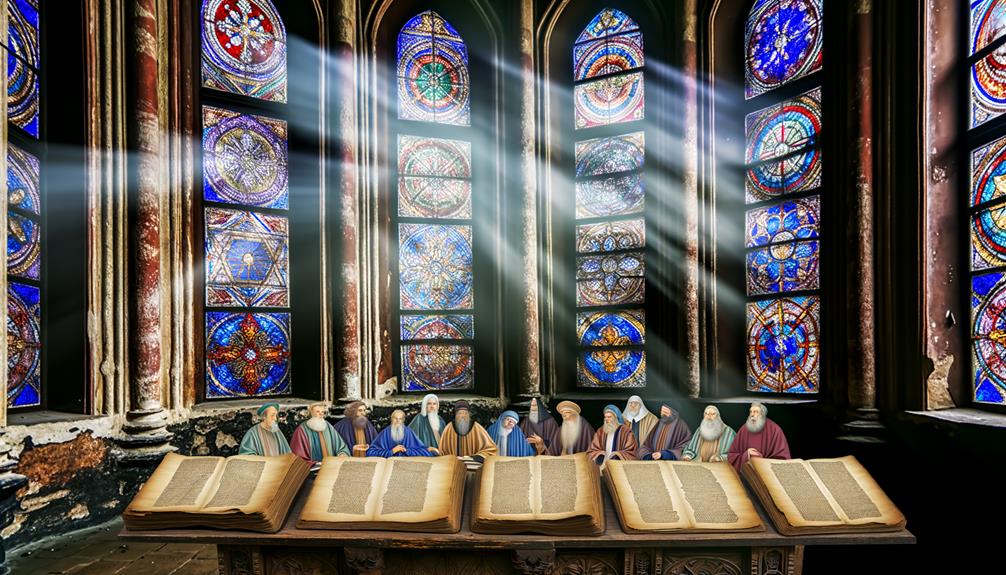Millennium Meaning in the Bible: Thousand-Year Reign
The Millennium in the Bible, primarily derived from Revelation 20:1-6, represents a thousand-year reign of Christ characterized by peace, divine justice, and the absence of Satan’s influence. Interpretations vary: Premillennialism views it as a literal future reign, Postmillennialism expects a golden age before Christ’s return, and Amillennialism sees it as symbolic of Christ’s present rule in believers’ hearts.
Historically, these interpretations have evolved in response to socio-political contexts and theological shifts within the early Church and medieval thought. Exploring these perspectives reveals deeper insights into eschatological beliefs and their implications for Christian doctrine.

Millennium Meaning in the Bible: 1,000-Year Reign and Prophetic Significance
| Aspect | Details |
|---|---|
| Definition | A 1,000-year period of Christ’s reign on Earth |
| Biblical Reference | Revelation 20:1–6 |
| Key Events | Satan bound, saints reign with Christ, a time of peace and righteousness |
| Symbolism | Represents divine justice, fulfillment of prophecy, and restoration |
| Theological Views | Premillennialism, Amillennialism, Postmillennialism |
| Spiritual Lesson | Highlights God’s ultimate authority, justice, and promise of eternal peace |
Biblical Origins

Frequently discussed among theologians, the concept of the millennium in the Bible finds its origins primarily in the book of Revelation. Revelation 20:1-6 provides a detailed description of a thousand-year reign of Christ, a period often referred to as the Millennium.
This passage presents a vision where Satan is bound, and martyrs reign with Christ, symbolizing a time of peace and righteousness. Theologically, the Millennium signifies a divine epoch distinct from human history, reflecting God’s ultimate sovereignty and justice.
Interpretations of the Millennium

Building upon the foundational biblical origins, interpretations of the Millennium among theologians have varied widely, reflecting diverse understandings of eschatological timelines and divine promises. These interpretations often align with theological perspectives on God’s ultimate plan for humanity and the cosmos. The table below outlines some key interpretations:
| Interpretation | Description |
|---|---|
| Premillennialism | Belief in Christ’s return before the Millennium, initiating a literal 1,000-year reign. |
| Postmillennialism | View that Christ will return after a golden age of Christian dominance on earth. |
| Amillennialism | The belief that the Millennium is symbolic, representing the current church age. |
| Dispensationalism | A form of premillennialism emphasizing distinct periods in God’s redemptive plan. |
| Historical Premillennialism | Similar to premillennialism but without dispensational distinctions. |
These varied interpretations illustrate the rich theological debates surrounding end-times prophecy.
Literal Vs. Symbolic Views

How do theologians reconcile the divergent views of the Millennium as either a literal 1,000-year reign or a symbolic representation of the church age?
Theological perspectives on the Millennium often hinge on interpretative frameworks and textual analysis. To navigate these perspectives, scholars consider:
- Biblical Exegesis: Analyzing scriptural texts, especially Revelation 20, to determine if the Millennium is a specific period or a metaphorical era.
- Historical Theology: Examining how early church fathers and subsequent theological traditions have understood and articulated the Millennium.
- Eschatological Models: Comparing premillennial, postmillennial, and amillennial views to understand how each framework affects the interpretation of the Millennium.
Historical Context

To fully comprehend the diverse interpretations of the Millennium, it is imperative to contemplate the historical context in which early Christian thinkers developed their eschatological views.
The nascent Christian community, forged in the crucible of Roman oppression and Jewish apocalyptic traditions, sought solace in prophetic texts. These early theologians often interpreted the Millennium through the lens of prevailing sociopolitical circumstances, which influenced their hopes for divine intervention and ultimate justice.
The destruction of the Second Temple in 70 AD and subsequent persecutions further shaped these eschatological narratives, fostering a milieu where the promise of a millennial reign symbolized both spiritual fulfillment and temporal vindication.
This historical backdrop is essential for understanding how the Millennium was conceptualized in early Christian thought.
Theological Implications

The theological implications of the millennium in the Bible pivot on various interpretations of prophecies, which influence eschatological understandings and the expectations of future events.
This era’s symbolic or literal nature remains a contentious topic, prompting debates on the realism of scriptural depictions. Evaluating these dimensions reveals the broader significance of millennium concepts within Christian doctrine and its impact on believers’ worldviews.
Interpretations of Prophecies
Interpreting biblical prophecies related to the millennium requires a nuanced understanding of eschatological themes and theological contexts. Theological scholars often approach these prophecies with various hermeneutical frameworks, leading to diverse interpretations.
Three primary interpretations are:
- Premillennialism: This view posits that Christ will return before a literal thousand-year reign, a period marked by peace and righteousness.
- Amillennialism: This interpretation suggests that the millennium is symbolic, representing the reign of Christ in the hearts of believers throughout the church age.
- Postmillennialism: This perspective holds that Christ will return after a golden age of Christian dominance and moral improvement.
Each interpretation reflects distinct theological implications that shape the understanding of biblical prophecy and its application to contemporary faith.
Eschatological Significance Explained
By examining the eschatological significance of the millennium, one can discern profound theological implications for the understanding of divine justice, ultimate redemption, and the consummation of God’s kingdom.
The millennium is seen as a period where Christ’s reign achieves its fullness, symbolizing the triumph of righteousness over evil. Theologically, it underscores the vindication of God’s sovereignty, as justice is meted out to the righteous and the wicked.
It reflects the hope for a renewed creation where peace and divine order prevail. Additionally, it encapsulates the final phase of God’s redemptive plan, highlighting the shift from temporal struggle to eternal glory.
This period fosters a deeper appreciation for God’s promises and the believer’s role in the divine narrative.
Symbolism and Realism Debate
While the eschatological significance of the millennium emphasizes divine justice and ultimate redemption, the debate between symbolism and realism further complicates its theological interpretation. This tension manifests in several key areas:
- Interpretive Framework: Symbolists view the millennium as an allegorical period representing the triumph of good over evil, whereas realists see it as a literal thousand-year reign of Christ on Earth.
- Scriptural Exegesis: Symbolists often cite the apocalyptic language of Revelation as inherently metaphorical, while realists argue for a more straightforward, historical reading.
- Theological Implications: The symbolic perspective underscores spiritual renewal and moral transformation, whereas the realist approach anticipates tangible, geopolitical changes during Christ’s reign.
This dichotomy influences eschatological doctrines and ecclesiastical teachings, shaping believers’ expectations and spiritual outlook.
Millennial Views in Church History

The concept of the millennium has been interpreted in various ways throughout church history, reflecting shifts in theological and eschatological thinking.
Early Church perspectives often embraced a literal thousand-year reign of Christ, while medieval interpretations began to allegorize this period, aligning it with broader spiritual narratives.
In modern times, theological debates have further diversified, ranging from premillennialism to amillennialism, each offering distinct understandings of eschatology within the Christian tradition.
Early Church Perspectives
Early Church perspectives on the millennium frequently illustrate diverse and evolving theological interpretations within the nascent Christian community. These perspectives can be categorized as follows:
- Premillennialism: Advocates, such as Papias and Justin Martyr, believed Christ would return before a literal thousand-year reign, reflecting a tangible fulfillment of biblical prophecies.
- Amillennialism: Originating with figures like Origen and later Augustine, this view interprets the millennium symbolically, viewing it as the current church age rather than a future period.
- Postmillennialism: Less common in early church writings, this perspective posits that Christ will return after a golden age of Christian dominance, emphasizing the transformative power of the gospel.
These early interpretations underscore the dynamic and multifaceted nature of eschatological thought in early Christianity.
Medieval Interpretations Emerge
Medieval theologians, building on the foundations laid by their predecessors, developed nuanced interpretations of the millennium that reflected the era’s complex socio-political and religious landscape.
These interpretations were often shaped by the prevailing circumstances of the times, including the Church’s growing influence and the constant threat of political upheaval.
| Theologian | Interpretation | Contextual Influence |
|---|---|---|
| Augustine of Hippo | Amillennialism | Decline of the Roman Empire |
| Joachim of Fiore | Historical Millennialism | Crusades and the anticipation of renewal |
| Thomas Aquinas | Allegorical Exegesis | Scholasticism and theological synthesis |
| Bernard of Clairvaux | Mystical Millennialism | Monastic reform and spiritual revival |
| Hugh of St. Victor | Typological Analysis | Educational reform and biblical study |
These views underscore the medieval Church’s attempt to contextualize eschatological beliefs within their contemporary framework.
Modern Theological Debates
Building upon these medieval interpretations, contemporary theological debates continue to explore the significance of the millennium within church history, often reflecting modern socio-political and ecclesiastical dynamics. Scholars and theologians engage in rigorous analysis of millennial views, focusing on:
- Premillennialism: This perspective anticipates Christ’s return before a literal thousand-year reign, emphasizing prophetic fulfillment and eschatological hope.
- Amillennialism: This view interprets the millennium symbolically, suggesting the reign of Christ is manifested through the church age, rather than a literal future event.
- Postmillennialism: Advocates believe Christ will return after a golden age of Christian ethics and societal transformation, reflecting optimism in human progress.
These diverse interpretations reveal the complexity and depth of millennial discourse in contemporary theology, shaping modern Christian thought.
Modern Perspectives

In contemporary theological discourse, interpretations of the millennium in the Bible often reflect diverse perspectives shaped by advancements in biblical scholarship and cultural contexts.
Scholars approach the millennium with varied methodologies, encompassing symbolic, historical-critical, and eschatological lenses. Some view the thousand-year reign as a metaphorical period representing Christ’s spiritual dominion, while others regard it as a future, literal reign on earth.
The influence of modern hermeneutics has led to a reevaluation of traditional views, resulting in a spectrum of interpretations ranging from pre-millennialism to amillennialism.
Additionally, cultural shifts influence theological stances, integrating contemporary issues such as justice, ecology, and globalism into millennial thought, thereby enriching the discourse with multifaceted insights and applications.
Significance for Christians

Understanding the millennium in biblical terms holds significant theological implications for Christians, as it shapes beliefs regarding the nature of Christ’s reign and the ultimate fulfillment of God’s promises.
The concept influences Christian eschatology in several key ways:
- Christ’s Sovereignty: The millennium underscores the anticipated period of Christ’s absolute rule, reflecting His divine authority over creation.
- Fulfillment of Prophecy: It is seen as the consummation of biblical prophecies, where God’s covenant promises to Israel and the Church reach their zenith.
- Eschatological Hope: The millennium provides a framework for understanding the final judgment and the establishment of a new heaven and earth, offering believers hope and motivation for faithful living.
These elements collectively enhance a Christian’s theological and spiritual outlook.
Conclusion
In examining the millennium’s biblical origins, interpretations, and theological implications, it becomes evident that its significance varies across historical and modern perspectives.
For instance, the early Church’s chiefly premillennial view contrasts sharply with the amillennial stance of many contemporary theologians. This divergence illustrates the complexity of interpreting eschatological themes.
Overall, the millennium remains a pivotal concept, inviting ongoing scholarly debate and reflection within Christian theology, shaping doctrinal beliefs and influencing religious practices.






